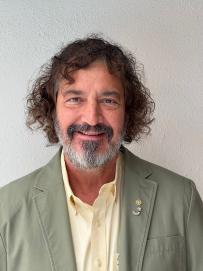Meet Chis Ray
Chicago, Illinois, U.S.

For Principal Structural Engineer Chris Ray, bigger is always better when it comes to bridge projects.
Chris has worked in bridge design and construction for most of his lengthy career, starting with his work at the North Carolina Department of Transportation after graduating with a degree in civil engineering from North Carolina State University and later receiving a master’s degree in structural engineering from the same university. He has worked on many notable bridges throughout his career, including serving as the Chief Viaduct Engineer for the Expo 2020 Dubai and as part of the design team on the Arthur Ravenel Jr. Bridge in Charleston, South Carolina, one of the largest cable bridges in the Americas.
His favorite projects, though, are working on railroad bridges, with a notable one being the Dallas Area Rapid Transit (DART) Cotton Belt Regional Rail Corridor Project. As a Railroad Bridge Engineer, Chris enjoys working on these specific bridges due to their complexity and robustness. Every bridge is different, each carrying its own set of complex challenges for him to solve. Wherever he goes next, Chris will always be building bridges along the way.
“They call engineering a practice because each project is practice. With every project, you get better, learn more and bring more expertise to the next project. The more you practice, the better you get.”
Get to know Chris
What is your favorite part of your role?
I enjoy being a true engineer and creating solutions for problems when you least expect them. For example, when I was in Dubai, I developed a device for the Metro rail system that could absorb lateral stress but still rotate and translate longitudinally.
The rail structure interaction analysis (RSI) indicates the force on a structure on a direct-fixed railroad bridge due to the different behavior of the rail and the bridge itself. If the rail is on a curve, you may need to create something with room to expand and contract with the temperature but be laterally restrained from the centrifugal forces induced by the train. So, we developed a shear key for the post-tensioned segmental box girders. The girders were independent of each other except for the continuous welded rail. This device eliminated the lateral stress in the rail. The device had very little lateral tolerance but would allow longitudinal translation and rotation without moving side-to-side. When it comes to situations like that, there are no textbook solutions, so I like being part of creating one.
When you aren’t working, what are we most likely to find you doing?
I play the banjo, and I like to get out and enjoy wherever I may be that week. I try to see people as often as possible, usually through music. There are a bunch of musicians I play with, and I enjoy spending time with them.
What do you enjoy about working with the communities where your projects are based?
Every community is unique. When working on these projects, you navigate the clients, stakeholders and the communities you are building within. They want their projects to look nice and work within their everyday lives. I have especially enjoyed getting to work with the Chicago community. They are friendly, and I look forward to the work I can do to help the region.
What do you enjoy most about #OurJacobs?
Jacobs is everything I ever wanted to find in a company. They are involved in everything and the best at everything they do. In my previous company, I was one of the most senior employees. At Jacobs, there are many people with different skill sets, and I can learn from them. Jacobs gives me a platform, a canvas to be mentored and to mentor others. It’s a great company.















































